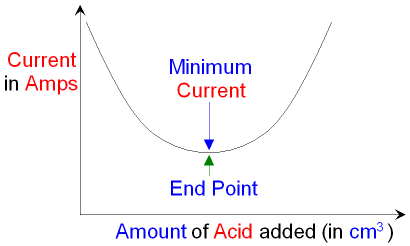
gcsescience.com 33 gcsescience.com
Using Conductivity to find the End Point of a Titration.
At the start of this
titration the conical flask
contains
a strong
alkali that
is fully ionised
in water.
If electrodes are placed inside the conical
flask
the ions in the water
will conduct electricity
and a current will flow.
Conductivity is a measure
of
how well the solution in
the conical flask
conducts
electricity.
The more ions there are the better the conductivity and
the higher the
current will be.
The current can be measured using an ammeter.
As acid is added to the alkali
hydrogen ions and hydroxide
ions
react together to form
water
molecules.
The number of ions in the conical
flask starts to decrease
and the current flowing through the
solution will decrease.
At neutralisation all of the hydrogen ions and hydroxide
ions
have
reacted together to form water
molecules.
The neutral solution contains
only salt ions dissolved in water
molecules.
The solution will still conduct electricity because of the salt
ions
but the current will be at a minimum.
As more acid is added the current will start to increase
because there
will now be unreacted hydrogen ions
in the solution as well as the
salt ions.
The solution is now no longer neutral but has become acidic.
If you draw a graph of current against the amount of acid added
you can see where the minimum is.
This is the end point
of the titration
at neutralisation.

The titration can be repeated
with the same amounts of acid and alkali used
at the end point.
Pure salt crystals can then be crystallised from the neutral solution.
![]() Links
Acids
and Alkalis
Revision Questions
Links
Acids
and Alkalis
Revision Questions
![]()
gcsescience.com The Periodic Table Index Neutralisation Quiz gcsescience.com
Home GCSE Chemistry GCSE Physics
Copyright © 2015 gcsescience.com. All Rights Reserved.